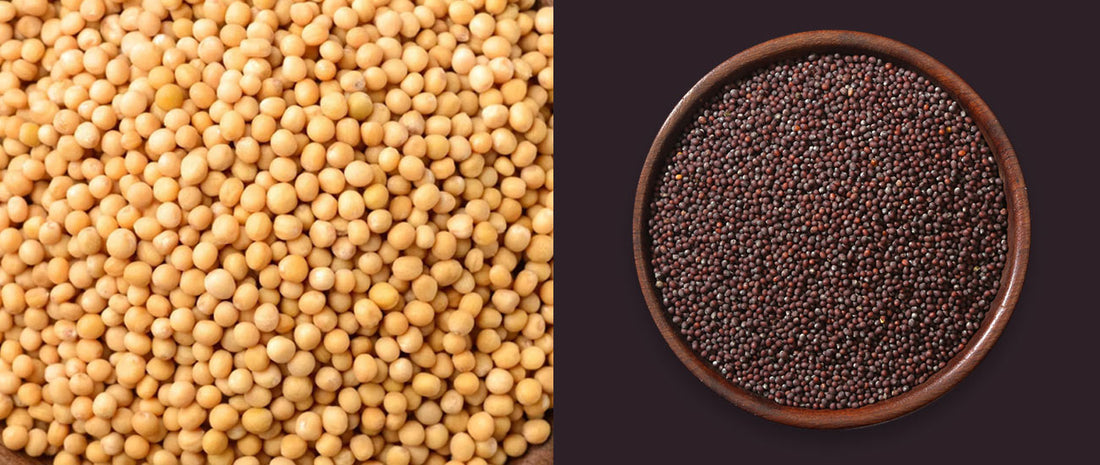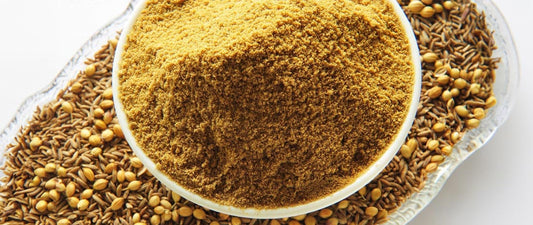Table of Contents
Mustard seeds may seem like tiny, simple additions to your spice rack, but their significance in the world of spices extends far beyond their size. These little seeds pack a punch of flavour and boast a rich history, along with a variety of uses in both the kitchen and traditional medicine. In this article, we'll explore everything you need to know about mustard seeds.
What are Mustard Seeds?
Mustard seeds are small and round, measuring about 1 to 2 millimetres in diameter. They come enclosed in a fruit pod, which is multi-seeded and dehiscent. The seeds can vary in colour from yellowish-white to black, depending on the variety and maturity. These seeds are the powerhouse of flavour and aroma in mustard, a condiment that has been a staple in kitchens worldwide for centuries.

Origins & Types of Mustard Seeds
Mustard seeds, derived from the mustard plant (Brassica juncea), come in various forms, each offering distinct flavours and culinary applications.
- Black Mustard Seeds (Brassica nigra): Black mustard seeds have a strong, sharp flavour profile, delivering a robust spiciness and slight bitterness. Commonly used in Indian and Southern European cuisines, these seeds play a crucial role in tempering and seasoning dishes. They are often tempered in hot oil at the beginning of the cooking process to release their full aroma and flavour, enhancing the overall taste of the dish.
- Brown Mustard Seeds (Brassica juncea): Brown mustard seeds are bolder in flavour compared to their yellow counterparts. They carry a pungent, spicy heat, with earthy undertones. This variety is frequently employed in Indian cuisine, contributing to the distinctive taste of many curries and spice blends. Brown mustard seeds are also used to make Dijon mustard, adding depth and heat to the condiment.
- Yellow Mustard Seeds (Brassica alba): These seeds, also known as white mustard seeds, are the mildest among the mustard varieties. They boast a subtle nutty and mildly tangy flavor. Yellow mustard seeds are commonly used in the preparation of American-style mustard condiments. They are also prevalent in pickling recipes, providing a gentle kick without overpowering other flavours.
The choice between yellow, brown, or black mustard seeds depends on the desired flavour intensity in a particular recipe. While yellow mustard seeds are more readily available and milder, brown and black mustard seeds offer a more assertive presence in dishes.

Culinary Uses of Mustard Seeds
Mustard seeds are a versatile ingredient in the kitchen. They are used in various cuisines and are a key component in both traditional and modern dishes. Here are some common culinary applications:
- Pickling: Mustard seeds are often used in pickling brines, contributing a spicy, aromatic element. For example: Dill Pickles, Bread and Butter Pickles, and Pickled Beets.
- Curries: Mustard seeds are a common ingredient in many curry dishes, providing a nutty, warm flavour. For example: South Indian Sambar, Bengali Fish Curry, Aloo Gobi.
- Stir-fries and Sautes: Mustard seeds are often used in stir-fries and sautés, especially in Indian cuisine. They are typically fried in oil until they pop, releasing their flavours. For example: Cabbage Thoran, Okra Stir-fry, Tadka Dal.
- Condiments: Ground mustard seeds are the main ingredient in prepared mustard condiments. For example: Dijon Mustard, Whole Grain Mustard, Honey Mustard.
- Soups and Stews: Mustard seeds can add depth and complexity to soups and stews. For example: Mulligatawny Soup, Vegetable Stew, Lentil Soup.
- Salad Dressings: Mustard seeds, especially when ground, can emulsify vinaigrettes, leading to a creamier salad dressing. For example: Honey Mustard Dressing, French Vinaigrette, Poppy Seed Dressing.
Health Benefits of Mustard Seeds
- Antibacterial properties: Mustard seeds contain compounds that have been shown to be effective against a variety of bacteria.
- Improved digestion: Mustard seeds are known to stimulate the production of gastric juices, which can help improve digestion.
- Anti-inflammatory effects: Mustard seeds contain compounds that have anti-inflammatory effects. A study found that mustard oil contains allyl isothiocyanate, which has anti-inflammatory potential.
- Respiratory relief: Mustard seeds have been used in traditional medicine to help relieve respiratory conditions like asthma, bronchitis, and cold symptoms. A study conducted in 2020 assessed the role of mustard in fighting against infections of the respiratory tract.
- Improved cardiovascular health: Mustard seeds are a good source of omega-3 and omega-6 fatty acids, which are known to improve heart health by reducing cholesterol levels and inflammation.
Here is the nutritional information for a 20-gram portion of mustard seeds:
| Nutrient | Amount |
|---|---|
| Calories | 101.6 calories |
| Fiber | 2.44 grams |
| Protein | 5.22 grams |
| Fat | 7.24 grams |
| Vitamin C | 1.42 milligrams |
| Vitamin K | 1.08 micrograms |
| Thiamin | 0.16 milligrams |
| Riboflavin | 0.05 milligrams |
| Niacin | 0.95 milligrams |
| Folate | 32.4 micrograms |
| Calcium | 53.2 milligrams |
| Iron | 1.84 milligrams |
| Zinc | 1.22 milligrams |
| Copper | 0.13 milligrams |
| Magnesium | 74 milligrams |
| Phosphorus | 165.6 milligrams |
| Potassium | 147.6 milligrams |
| Sodium | 2.6 milligrams |
| Manganese | 0.49 milligrams |
| Selenium | 41.6 micrograms |
Please note that this is an approximate value and actual nutritional content may vary based on the variety and preparation of the mustard seeds.
How to Use Mustard Seeds in Cooking
- Toast the Seeds: Begin by gently toasting the mustard seeds on a dry pan over medium heat. This step releases the aromatic oils and enhances the flavour of the seeds. Be careful not to burn them, as it can result in a bitter taste.
- Crush or Grind: Once the seeds are toasted, you can crush them using a mortar and pestle or grind them in a spice grinder. This step is optional and depends on the recipe. Some recipes may call for whole seeds, while others may require them to be crushed or ground.
- Use Sparingly: Keep in mind that mustard seeds have a potent flavour, and a little can go a long way. Start with a small quantity in your recipe and adjust to your preferred level of flavour intensity. This approach ensures that the distinctive mustard flavour complements your dish without overpowering it.
Remember, mustard seeds can pop and splatter when heated, so use a lid or splatter screen when toasting them.

Storage & Shelf Life of Mustard Seeds
To store mustard seeds effectively, transfer them into an airtight container immediately after purchase, preferably one that is opaque to shield them from light. Place this container in a cool, dark location, away from temperature fluctuations and moisture, as both can compromise the quality. Keeping the seeds whole (rather than grinding or crushing) until use is advisable to retain their essential oils and flavour. When stored under these conditions, mustard seeds can maintain their freshness for up to a year, though for the best flavour, consider replacing them annually or when their aroma and taste noticeably diminish.
Read more: 7 Simple Tips to Store Spices
Mustard Seed Alternatives
Mustard seeds have a distinct flavour, but if you don’t have them on hand, there are several alternatives you can use instead, such as wasabi, horseradish, arugula, or turmeric.
When choosing a substitute, consider the flavour profile of the dish you are making and start with a small amount, adjusting to taste as needed. Experiment with different mustard seed substitutes to find the ones that you like best and that work best in your favourite recipes. Remember, the goal is to mimic the heat and pungency of mustard seeds without overpowering the dish.
Conclusion
Whether you’re using mustard seeds in savory dishes, condiments, or as a pickling agent, mustard seeds infuse a touch of warmth and pungency to your dishes. So, the next time you cook, consider adding a sprinkle of these tiny seeds and experience the magic they bring to your dishes.



